
Viewing: Blog Posts Tagged with: sculpture, Most Recent at Top [Help]
Results 1 - 25 of 210
Blog: Paper Pop-Ups (Login to Add to MyJacketFlap)
JacketFlap tags: health, doctor, sculpture, statue, business card, model, dr, petrina case, Add a tag
Blog: drawboy's cigar box (Login to Add to MyJacketFlap)
JacketFlap tags: sculptor, rake, Drawboy, chisel, illustration friday, farmer, sculpture, chimney sweep, Patrick Girouard, tool, Add a tag
Blog: Read Write Believe (Login to Add to MyJacketFlap)
JacketFlap tags: ekphrastic poetry, Poetry, Poetry Friday, Art, Sculpture, Picasso, Add a tag
Response to Picasso’s sculpture of a Cat
She’s pregnant, this cat
or just given birth. She’s muddy;
her tail's been broken.
Look at her neck, stiff
as a stanchion. Look at her compact
head; so ill-made for big thoughts
you fear her tail is pulling
her backwards. She isn’t curled
by contentment, or preying
with merciless grace, or cagily
sinuous. Still—
she is Cat. She disdains
opinion. You can tell
by the vainglorious shine
of her ears, as if she is listening to
an undivided convent
of cats chanting her name
lapping up her blessing
as she passes them. She has lived
fully; they have been holy.
Picasso stretched time between
sculptures; using his brush to pry apart
skulls, turning to his hands only when the Muse
purred to him. He was never trained
to mold clay or pour bronze but
what he made, he kept
close. They fattened
his household. Did he speak
to Cat? Attempt to straighten
her tail, even as she hissed? How do
you feed a Muse who doesn’t need
you? She’s given birth; he stirs mud.
----Sara Lewis Holmes (all rights reserved)
Thanks to Liz Garton Scanlon for discovering the intriguing Picasso sculptures, which provided the inspiration for this month's ekphrastic poetry challenge. (The Poetry Seven plans to respond to an image or piece of art every other month in 2016. I'm already researching which artist to choose when it's my turn...)
Here are the links to my Poetry Sisters' poems (each of us chose a Picasso sculpture from a select group, so there's some overlap in the inspiration images, but glorious uniqueness in the response!)
Liz
Tanita
Tricia
Laura
Andi (taking a breather this month)
Kelly
More about Picasso's sculptures.
Poetry Friday is hosted today by one of the Poetry Seven's own, Tricia, at The Miss Rumphius Effect.
Blog: Gurney Journey (Login to Add to MyJacketFlap)
JacketFlap tags: Sculpture, Add a tag
Artists have left works unfinished inadvertently because time, the weather, or death called them away. Such partially completed works often provide insights as to how they were executed.
 |
| Danäid, 1889, Auguste Rodin (source) |
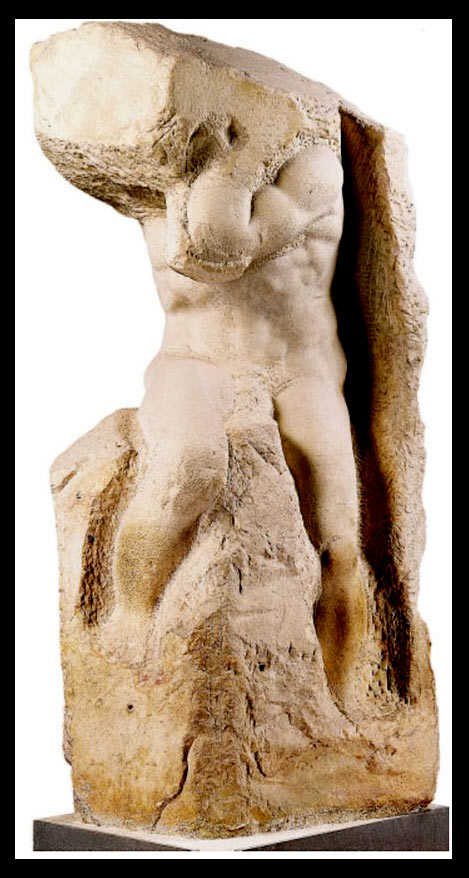 Michelangelo (left) and Donatello are also notable for their non finito sculptures, where the figure sometimes seems to be contending against its imprisonment in stone.
Michelangelo (left) and Donatello are also notable for their non finito sculptures, where the figure sometimes seems to be contending against its imprisonment in stone.The Process of Artistic Creation in Terms of the Non-finito
GurneyJourney on sprezzatura
Blog: Illustration Friday Blog (Login to Add to MyJacketFlap)
JacketFlap tags: design studio, design, illustration, art, artists, graphic design, sculpture, installations, paper craft, Add a tag






Zim & Zou are Lucie Thomas and Thibault Zimmermann, they are two french artists based in Nancy. They use handcrafted objects to make beautiful colourful installations. They studied graphic design for three years whilst at art school, but their studio works in a variety of multidisciplinary ways incorporating illustration, graphic design and paper sculptures. There favourite material to use is paper, making everything by hand.
To find out more visit their website and Behance.
Blog: Gurney Journey (Login to Add to MyJacketFlap)
JacketFlap tags: Sculpture, Add a tag
Blog: OUPblog (Login to Add to MyJacketFlap)
JacketFlap tags: Poetry, classics, homosexuality, sculpture, youth, sex, Oxford World's Classics, Latin, cicero, Ancient Rome, Epigrams, *Featured, homoerotic, Classics & Archaeology, Arts & Humanities, #owcreads, Marcus Valerius Martialis, OWC Reading Group, Pliny the Elder, Add a tag
Martial adores sexy boys. He craves their kisses, all the more so if they play hard to get, "� buffed amber, a fire yellow-green with Eastern incense… That, Diadumenus, is how your kisses smell, you cruel boy. What if you gave me all of them, without holding back?" (3.65) and "I only want struggling kisses – kisses I’ve seized; I get more of a kick out of your bad temper than your good looks…" (5.46).
The post ‘I get more of a kick out of your bad temper than your good looks': Martial’s guide to getting boys appeared first on OUPblog.
Blog: andrea joseph's sketchblog (Login to Add to MyJacketFlap)
JacketFlap tags: moleskine, watercolour, sketchbook, sculpture, AJ, Yorkshire Sculpture Park, andrea joseph, Andrea Joseph drawings, Moleskine artist, #inktober, inktober2015, Henry Moore, reclining nude, illustrator, illustration, Add a tag
Blog: Paper Pop-Ups (Login to Add to MyJacketFlap)
JacketFlap tags: pick, petrina case, glass dome, wood base, rickenbacker, music, sculpture, statue, guitar, business card, model, Add a tag
Blog: OUPblog (Login to Add to MyJacketFlap)
JacketFlap tags: art, Philosophy, painting, beauty, sculpture, brain, aesthetics, Plato, neuroscience, *Featured, Science & Medicine, neurons, Psychology & Neuroscience, Francisco Mora, Add a tag
Can you imagine a concert hall full of chimpanzees sitting, concentrated, and feeling 'transported' by the beauty of Beethoven’s Ninth Symphony? Even harder would be to imagine a chimpanzee feeling a certain pleasure when standing in front of a beautiful sculpture. The appreciation of beauty and its qualities, according to Aristotle’s definition, from his Poetics (order, symmetry, and clear delineation and definiteness), is uniquely human.
The post Beauty and the brain appeared first on OUPblog.
Blog: Beth Kephart Books (Login to Add to MyJacketFlap)
JacketFlap tags: Remains to Be Seen, Sculpture, National YoungArts Foundation, Mary Lee Adler, Add a tag
I met Mary Lee Adler in Miami. She was (in her smart, loving, embracing way) overseeing the young writers of the National YoungArts program. Making sure they were heard. Making sure they were seen. Making sure they were experiencing all that week-long program had to give them.
But here's the thing: If those YoungArts writers did nothing more than meet Mary Lee, their week in the Miami sun would have been worth it. I've rarely enjoyed conversation as much as I enjoyed my conversation with this reader/maker/doer. I've rarely felt so privileged.
A Vanderbilt graduate with an English degree, a woman who has traveled the world, a woman who doesn't give up on love or its possibilities, Mary Lee is also a sculptor—a maker of exquisite urns, among other things.
Today I'm celebrating Mary Lee and her artful renditions of the everlasting. Please visit her web site to learn more.
Blog: Scribble Chicken! Art and Other Fun Stuff (Login to Add to MyJacketFlap)
JacketFlap tags: Art History, sculpture, Animal Art, paper sculpture, Art and Culture, scribble kids, kids art class, kids art ohio, 3-d art, art india, indian elephants, kids art classes, kids art india, northeast ohio art, painted elephants, collage, kids art, Add a tag
Kids art India class
We learned about the history, culture and art of India today and had a lot of fun!
Our main project today was recreating the ‘painted elephant festival’ of Jaipur, India. Here are some cool examples of painted elephants from the festival:
We created 3-dimensional paper sculptures with collage elements and decorated them with colored pencil ‘paint.’
Here are some of our final creations:
We also enjoyed a traditional Indian snack recipe, with mixed reviews! (It used a lot of spices the children were not familiar with, plus it was vegetables). I did not include the tofu or the peanuts in our recipe.
Corn Chaat
Corn, tofu, onion, tomato, carrot, coriander, lemon juice, salt, pepper
Prep time
5 mins
Cook time
10 mins
Total time
15 mins
A quick salad snack made with corn, indian cottage cheese and raw veggies
Author: Swasthi
Recipe type: Snack
Cuisine: Indian
Yield: 2
Ingredients (240 ml cup used)
· 1 cup of corn kernels (boiled)
· 10 paneer or tofu cubes
· ½ small onion finely chopped
· ½ small tomato finely chopped
· ½ carrot grated
· 1 green chili (optional, skip for kids)
· Few coriander leaves / cilantro chopped
· Chat masala powder as needed
· Amchur if needed (your chat masala will already have amchur, so add only if needed) or lemon juice
· Salt as needed
· Pepper powder if needed
Instructions
1. Wash corn under running water. If using corn on the cob, soak them in salted water for sometime. Any pesticide residue will just get rinsed well. Boil the corn cobs or corn kernels in a large bowl filled with water. If using cobs, remove the kernels after boiling. Drain water completely. If you are using tender corn, you can alternately steam the corn to retain nutrients.
2. Cut paneer to small chunks. Tawa fry paneer in just one tsp ghee.
3. Add all the ingredients and toss well and serve corn chaat immediately while hot. If desired you can top it with crunchy roasted peanuts.
The post Kids Art India appeared first on Scribble Kids.
Add a CommentBlog: Silver Apples of the Moon (Login to Add to MyJacketFlap)
JacketFlap tags: Tim Bruckner, sculpture, TLCWorkshops, Add a tag
Blog: Mo Willems Doodles (Login to Add to MyJacketFlap)
JacketFlap tags: Appearances, Comix, Theater, sculpture, Add a tag
APRIL UPDATE! April is a fun month, the beginning of Mud Season here in central MA. I've got a few appearances and lots of theater happening this month, all of which I hope you enjoy if you get the chance to pop by. ANNIVERSARY My first book, DON'T LET THE PIGEON DRIVE THE BUS! was published 12 years ago on April 1st thanks to the efforts of my agent, Marcia Wernick, editor, Alessandra
Blog: Constructions: joyce audy zarins (Login to Add to MyJacketFlap)
JacketFlap tags: contest, marketing, Art, Boston, sculpture, life in general, contemporary art, creative living, Joyce Audy Zarins, Add a tag
What do Ezra Jack Keats, Sylvia Plath, Stephen King, Richard Avedon, Truman Capote, Robert McClosky, and Andy Warhol have in common, besides being incredibly creative? Ding. Time’s up. Each won a Scholastic Art & Writing Award when they were in their teens. Of this experience Richard Avedon, among others, said winning was “the defining moment […]
Add a CommentBlog: PW -The Beat (Login to Add to MyJacketFlap)
JacketFlap tags: Art, sculpture, Top News, animal battle, maryanna hoggatt, Add a tag
Portlandia artist Maryanna Hoggatt specializes in highly detailed statues of animal warriors that are pretty spectacular—fans of Tooth and Claw take note.
The statue shown above is about 10″ high and made from Super Sculpey, apoxie sculpt, armature wire, acrylic, fabric, ink, wood base. Her site also includes illos of the animals depicted. You can see her entire Animal Battle series here.
She also makes comics, such as this one based on her time as a bartender.
Blog: Gurney Journey (Login to Add to MyJacketFlap)
JacketFlap tags: Portraits, Sculpture, Add a tag
Madame Tussauds created this video about how they create a wax portrait figure. They had the benefit of having the subject, Benedict Cumberbatch, available for measurements and color matches. (link to video)
One of the readers of this blog is Jethro Crabb, a painter and sculptor who has worked at Madame Tussauds. I asked him a few questions prompted by the video.
James Gurney: Who sculpted the head in the video?
Jethro Crabb: "My friend John Cormican, a lovely fellow and a veteran of Jim Henson's creature shop amongst other places, sculpted the head for the Benedict Cumberbatch figure."
Jethro Crabb: "The studios are based in Acton, West London and produce wax figures for all the worldwide attractions. Each figure normally has two sculptors working on it, one to sculpt the body and one the head. I specialised in head sculpts during my time there."
JG: Do you ever use 3D scanners?
J. Crabb: "Tussauds to me is fascinating because most of the techniques involved in the production of the figures are exactly the same as they were 200 years ago. In the last couple of years 3D scanning and printing has become a part of the process, but the 3D prints are currently only used as another reference tool for sculpting in clay by hand."
JG: Do you always have a living celebrity available to pose?
J. Crabb: "In the case that the celebrity was free and willing to meet us, we would travel to them and take hundreds of photographs and measurements of them. For the head we used an eyebrow pencil to draw a matrix of dots on their faces which became points to measure from. As we built the clay head up using the photographic reference we established these points in the clay using metal pins and carefully measured between them with calipers. We would compare these measurements with our chart of measurements taken in the sitting and adjust them until correct. Two of the photographs we took were a 'front on' and a 'profile' shot in the right facial expression from 5 meters away (to minimize the distortion)."
"These were printed out 2% larger than life size and we used this to directly take measurements in a very specific way. The clay head was built 2% larger to compensate for shrinkage in the wax cast. In the case that the celebrity didn't want to be involved or was unavailable we would work from photographs alone. Each portrait would normally take 5 weeks to sculpt. All these techniques and processes were tinkered with and added to over the years and the results produced could be quite remarkable."
J. Crabb: "One of the things I learned as an artist working at Tussauds was that in order to create a convincing likeness of someone it was crucial that all the elements were correct and had the correct relationship with each other. Humans are so expert in recognising faces, or more accurately 'heads' since the shape and silhouette of the cranium, neck and jaw play an important role in this recognition, that any minor mistake or mismatch of forms creates a disproportionately disastrous result."
"I also learned more and more that it is the big simple shapes in a sculpture which are the most important to establish correctly. There is always a tendency to be distracted by an alluring nostril shape or mouth corner, but even if this small stuff is correct it is useless unless it is laying over a correctly sculpted larger form. Perhaps a similar thing can be said of painting."
JG: When it comes to recognizing a particular face, I have always been under the impression that the great portrait painters engage in subtle caricature (see post on "Caricature and Likeness") or at least are selective about downplaying certain features or qualities that are not particularly characteristic. Am I right in understanding that there's none of that going on with Madame Tussauds sculptures? Are you going for a metrically exact mirror image with no attempt to exaggerate characteristic details?
 Jethro Crabb: "This subject of 'caricature vs exact copy' that you bring up is one that absolutely fascinates me. Your question and original blog post has hit upon an issue that I have spent a lot of time thinking about and experiencing through my sculpture. Please excuse my lengthy response. It should be an easy question to answer, but it is not."
Jethro Crabb: "This subject of 'caricature vs exact copy' that you bring up is one that absolutely fascinates me. Your question and original blog post has hit upon an issue that I have spent a lot of time thinking about and experiencing through my sculpture. Please excuse my lengthy response. It should be an easy question to answer, but it is not.""At Madame Tussauds, the sculptors are aiming to produce an exact copy of the person. So that you could stand the celebrity next to their sculpture and it would be impossible to spot any differences in size, proportion, form or colour between the two, (By the way this aim is rarely if ever 100% achieved no matter how meticulously the wax figure is made)."
"But in order to get to that point I think it is helpful to have a caricaturist's eye. To have the ability and inclination to notice what specific characteristics are key in making someone look the way they do. This skill is particularly important when we have been unable to meet the celebrity in question and are just working from photographs without the aid of measurements taken from the subject. In this case it is useful to observe which characteristics of their head shape and features and they way they fit together are distinctive and might be exaggerated if we were to make a caricature. By noticing these characteristics we can make sure they are stated clearly enough in the sculpture. Better that they are slightly overstated than understated."
 |
| Wax portrait of Beethoven by Jethro Crabb |
J. Crabb: "A good wax figure should look like how people expect that celebrity to look. This can often be subtly different to the reality. Think about having your photo taken and having a feeling that it didn't quite capture how you really look. This could easily be the case with a wax figure as well. We could create a sculpture that measures correctly and adds up with all the photographs from the sitting, but just doesn't look like how we expect Johnny Depp, for instance, to look. So sometimes we have to choose photographic reference which tallies with our expectations. On top of this some of the best portrait sculptors at Tussauds use elements of subtle exaggeration in their modelling to define the characteristics of the forms and shapes in the face. Two of the principal sculptors used to work as caricaturists for the British television political caricature programme "Spitting Image" and I think this has helped with their realistic work."
Thanks so much, Jethro!
Jethro Crabb's sculpture work
Celebrity Tussaud images are from FanPop
Blog: Constructions: joyce audy zarins (Login to Add to MyJacketFlap)
JacketFlap tags: Art, process, sculpture, commissions, life in general, contemporary art, kinetic, environmental art, public sculpture, Add a tag
Yesterday was a beautiful fall day; perfect for a touch-up on Heron’s Dream. This kinetic sculpture, a collaboration between The Acton-Boxborough Cultural Council, the town of Acton’s NARA Park, Carolyn Wirth, and myself, was installed after the pond froze last winter. The grant process, town approvals and contract negotiations meant that I could not fabricate […]
Add a CommentBlog: paperwork (Login to Add to MyJacketFlap)
JacketFlap tags: The Arts Center, community, teaching, kids art, sculpture, fiber, Add a tag
 |
| 6-9 year old class |
Blog: paperwork (Login to Add to MyJacketFlap)
JacketFlap tags: teaching, kids art, sculpture, calder, art camp, Add a tag
| wiresculpture, Aine age 6 |
 |
| circus parts, mixed media, Nora age 8 |
Blog: Constructions: joyce audy zarins (Login to Add to MyJacketFlap)
JacketFlap tags: Art, sculpture, contemporary art, creative living, Joyce Audy Zarins, public sculpture, Add a tag
Today we installed The Whistler (painted steel, 101″ x 18″ x 18″) at the wonderful Sanctuary Arts in Eliot, Maine. Christopher Gowell is an amazing woman who has collected a vibrant community of artists who take and teach workshops and live life creatively. Josh and Lauren run a foundry there too. And every summer there […]
Add a CommentBlog: Ellis Nadler's Sketchbook (Login to Add to MyJacketFlap)
JacketFlap tags: woman, religion, computer, death, Nadler, sculpture, fire, iPad, Add a tag
I ate some dodgy prawns and had a vision of St.Fractalius.
Click to enlarge.
Blog: Gurney Journey (Login to Add to MyJacketFlap)
JacketFlap tags: Animation, Sculpture, Add a tag
The Academy Award for best animated short film last night went to "Mr Hublot," which is available free on YouTube. (Direct link to video)
Mr HUBLOT ArtBook (the art of Mr Hublot) from MrHublot on Vimeo.
The film is about "a withdrawn, idiosyncratic character with OCD, scared of change and the outside world. Robot Pet's arrival turns his life upside down: he has to share his home with this very invasive companion."
The production took three years, a lot of which was spent in planning the world that surrounds Mr Hublot's little apartment. The entire city has a mechanical, steam-driven flavor, as if it's made of old toasters and adding machines.
It was created in 3D digital, but the look was inspired by the physical sculptures of Stéphane Halleux. Filmmaker Laurent Witz says: "We had to find the balance between the coldness of the industrial world and the warmth of stone, leather, and the Haussmann architecture."
More:
See more preproduction art at Cartoon Brew
All images in this post are copyright ZEILT Productions and Stéphane Halleux
Blog: ERIC BARCLAY (Login to Add to MyJacketFlap)
JacketFlap tags: painted packaging, Halloween, children's, Sculpture, recycled, pomegranate juice, Add a tag
Blog: Laurasmagicday (Login to Add to MyJacketFlap)
JacketFlap tags: SFINE, Wordless Wednesday, Arts, sculpture, Add a tag
View Next 25 Posts

















 Made from 20 cards you send
Made from 20 cards you send











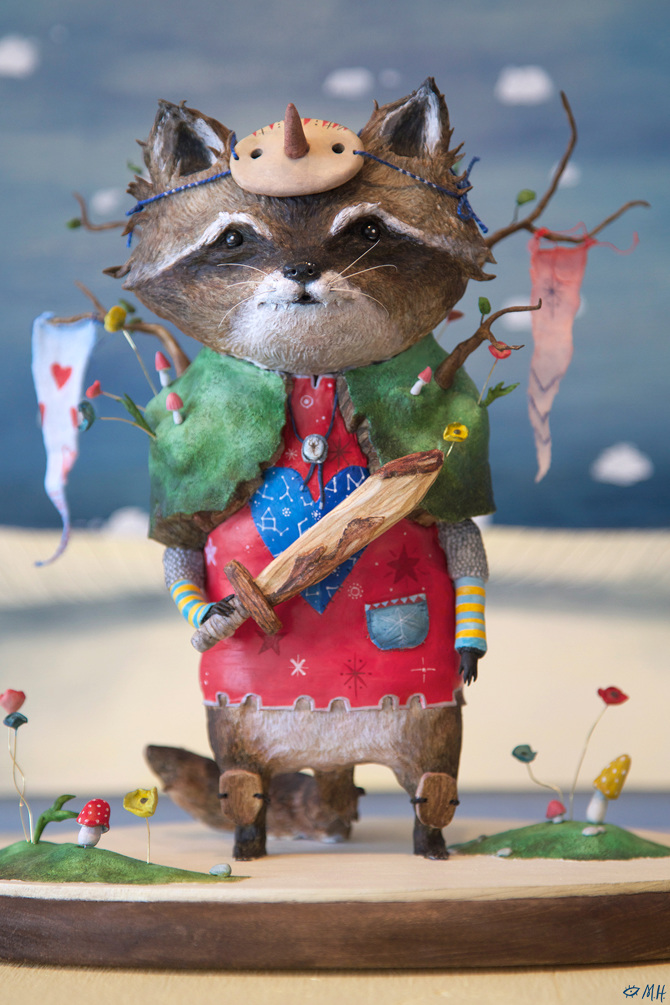
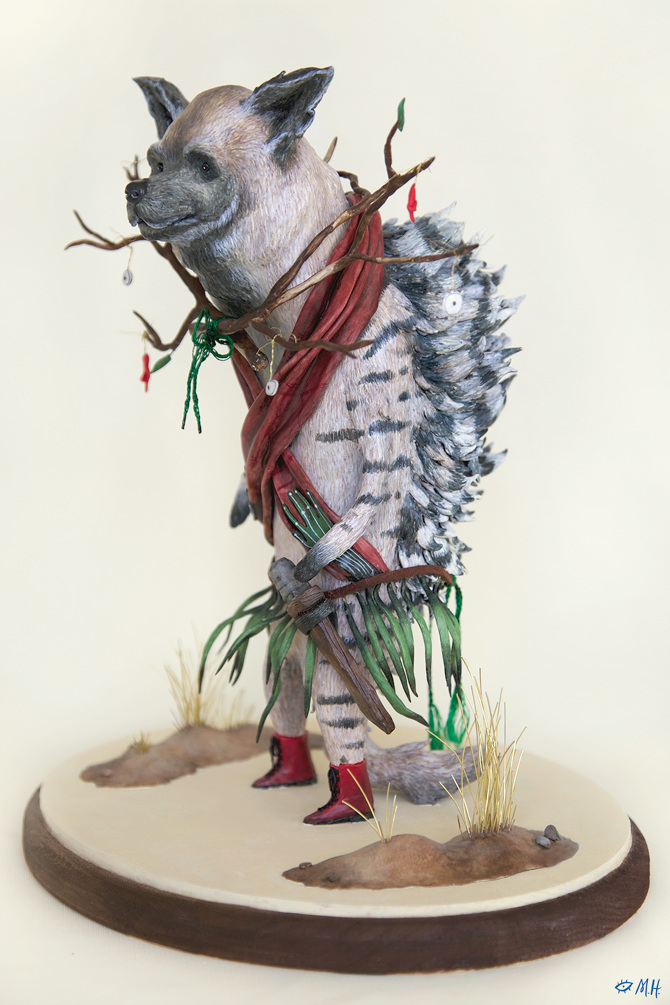

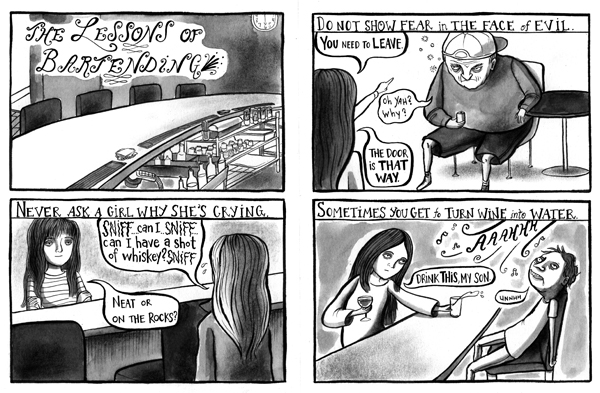







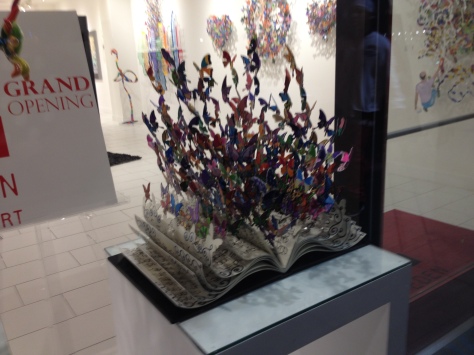
Brilliant, as usual! BTW, my 1 1/2 year old is OBSESSED with your book ICSJF! I'm going to have to buy a copy. She can only say "I" but she sees the book and starts screaming "I, I, I". I'm afraid the book is getting loved to pieces but I'm excited to purchase a fresh new copy to store away for their kids someday. So cool!!!
Thank you, Michaele!
I love it! Wish it was Halloween again ;)
What you do is inspiring. I make my son painted animals from recycled food boxes. This is wonderful♥ Great way to reuse items that would other wise be thrown away.
Thanks so much Berenice and Sophia!